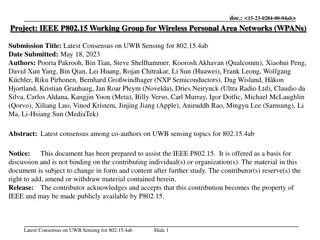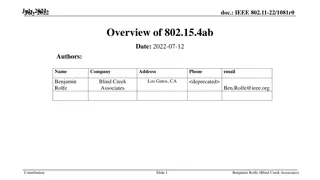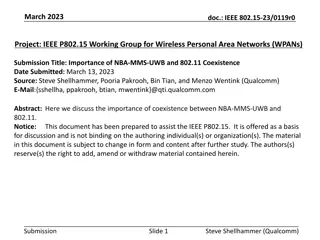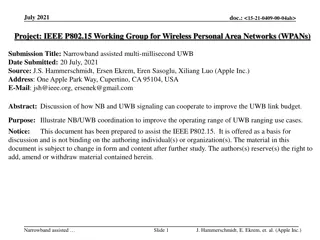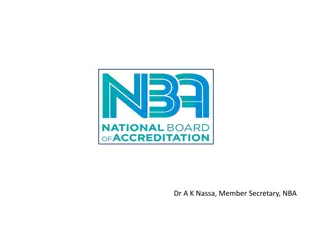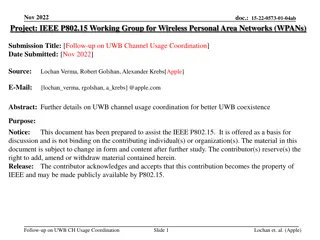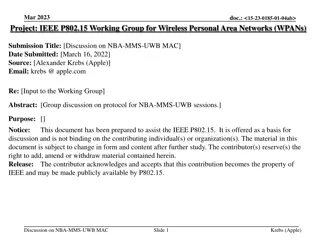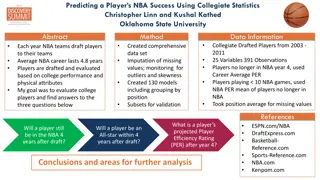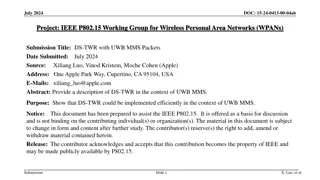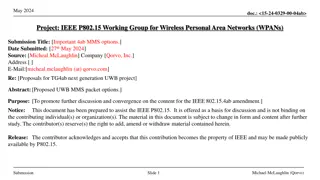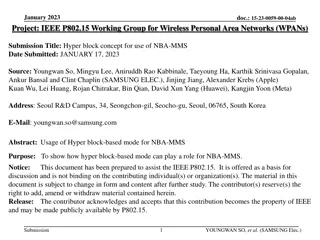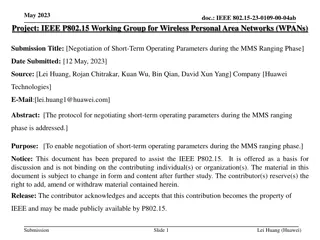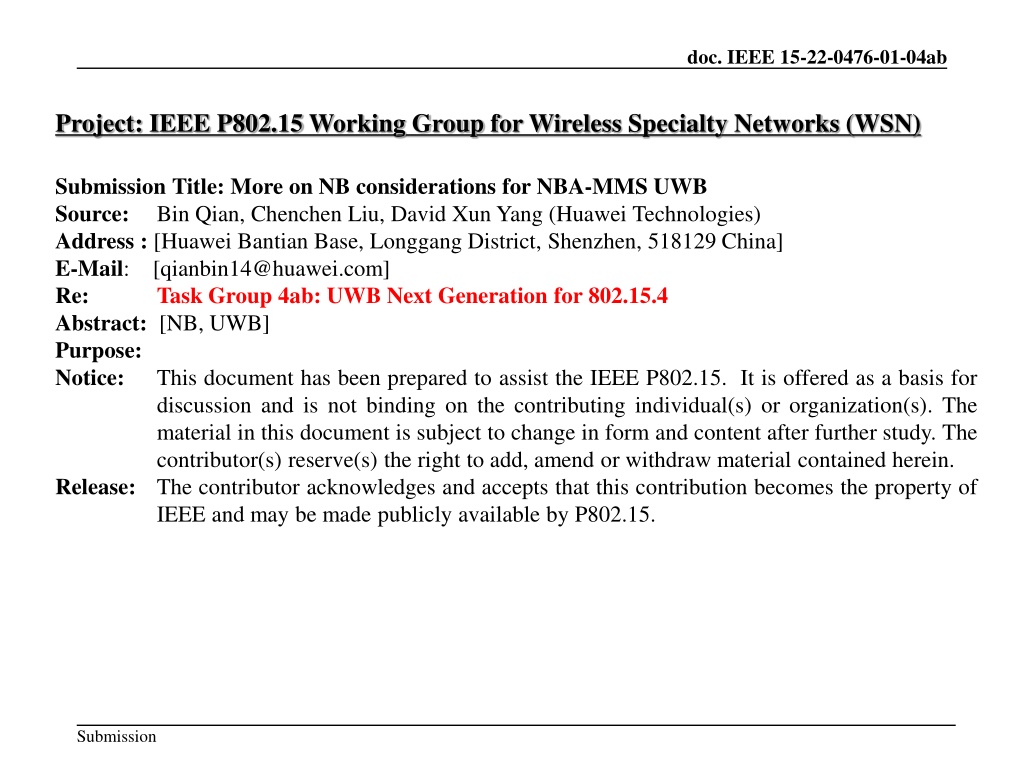
Enhancing NB Considerations for UWB in Wireless Networks
Explore the considerations and proposed solutions for integrating narrowband (NB) technology with ultra-wideband (UWB) in wireless networks. Topics include interference mitigation, coexistence improvements, configuration indications, and symbol-to-chip mapping for improved performance. The document emphasizes clock synchronization and CFO estimation between NB and UWB for optimal functionality.
Download Presentation

Please find below an Image/Link to download the presentation.
The content on the website is provided AS IS for your information and personal use only. It may not be sold, licensed, or shared on other websites without obtaining consent from the author. Download presentation by click this link. If you encounter any issues during the download, it is possible that the publisher has removed the file from their server.
E N D
Presentation Transcript
doc. IEEE 15-22-0476-01-04ab Project: IEEE P802.15 Working Group for Wireless Specialty Networks (WSN) Submission Title: More on NB considerations for NBA-MMS UWB Source: Bin Qian, Chenchen Liu, David Xun Yang (Huawei Technologies) Address : [Huawei Bantian Base, Longgang District, Shenzhen, 518129 China] E-Mail: [qianbin14@huawei.com] Re: Task Group 4ab: UWB Next Generation for 802.15.4 Abstract: [NB, UWB] Purpose: Notice: This document has been prepared to assist the IEEE P802.15. It is offered as a basis for discussion and is not binding on the contributing individual(s) or organization(s). The material in this document is subject to change in form and content after further study. The contributor(s) reserve(s) the right to add, amend or withdraw material contained herein. Release: The contributor acknowledges and accepts that this contribution becomes the property of IEEE and may be made publicly available by P802.15. Submission
Slide 2 doc. IEEE 15-22-0476-01-04ab PAR Objective Safeguards so that the high throughput data use cases will not cause significant disruption to low duty-cycle ranging use cases Interference mitigation techniques to support higher density and higher traffic use cases Other coexistence improvement Backward compatibility with enhanced ranging capable devices (ERDEVs) Improved link budget and/or reduced air-time Proposed Solution (how addressed) Additional channels and operating frequencies Improvements to accuracy / precision / reliability and interoperability for high-integrity ranging Reduced complexity and power consumption 1. Improved symbol-to-chip mapping to assist the CFO estimation and achieve better error performance Hybrid operation with narrowband signaling to assist UWB 2. NB configuration indication Enhanced native discovery and connection setup mechanisms Sensing capabilities to support presence detection and environment mapping Low-power low-latency streaming Higher data-rate streaming allowing at least 50 Mbit/s of throughput Support for peer-to-peer, peer-to-multi-peer, and station-to- infrastructure protocols Infrastructure synchronization mechanisms Submission
September 2022 doc. IEEE 15-22-0476-01-04ab NB Background The tight clock synchronization between NB and UWB could be used by NB to provide initial CFO to UWB In [1], the PPDU formats in Clause 12 of IEEE 802.15.4-2020 are recommended as the NB candidate Clause 21 in IEEE 802.15.4-2020 introduces a pilot insertion method Periodic insertion of known chip sequences (pilots) into the stream of PSDU chips shall be used to assist the CFO estimation or phase tracking during receive, taking the finite coherence time of the radio channel into account Submission Slide 3 Bin Qian, Chenchen Liu, Huawei
September 2022 doc. IEEE 15-22-0476-01-04ab Symbol-to-chip Mapping Data symbol 16-length Chip value ?0,?1, ?15 32-length Chip values ?0,?1, ?31 0 1 1 1 1 1 1 1 1 1 1 1 1 1 1 1 1 1 1 0 0 1 0 1 0 1 0 0 1 0 0 0 0 1 1 0 0 1 0 1 0 0 1 1 0 1 1 1 1 1 1 0 1 0 1 0 1 0 1 0 1 0 1 0 1 0 1 0 1 0 1 1 0 0 1 1 1 1 0 1 1 0 1 0 1 0 1 1 0 0 0 0 0 0 1 0 0 1 2 1 1 0 0 1 1 0 0 1 1 0 0 1 1 0 0 1 0 0 1 0 0 0 0 1 1 0 0 1 0 1 0 1 0 0 1 0 0 0 0 0 0 1 1 0 1 0 1 3 1 0 0 1 1 0 0 1 1 0 0 1 1 0 0 1 1 1 1 1 0 1 1 0 1 0 1 0 1 1 0 0 1 1 1 1 0 1 1 0 0 1 0 1 0 0 1 1 4 1 1 1 1 0 0 0 0 1 1 1 1 0 0 0 0 1 0 0 1 1 1 1 1 0 0 1 1 1 0 1 0 1 0 0 1 1 1 1 1 1 1 0 0 0 1 0 1 5 1 0 1 0 0 1 0 1 1 0 1 0 0 1 0 1 1 1 1 1 1 0 0 1 0 1 0 1 1 1 0 0 1 1 1 1 1 0 0 1 1 0 1 0 0 0 1 1 6 1 1 0 0 0 0 1 1 1 1 0 0 0 0 1 1 1 1 0 0 0 1 0 1 0 1 1 0 0 0 0 0 1 1 0 0 0 1 0 1 1 0 0 1 1 1 1 1 7 1 0 0 1 0 1 1 0 1 0 0 1 0 1 1 0 1 0 1 0 0 0 1 1 0 0 0 0 0 1 1 0 1 0 1 0 0 0 1 1 1 1 1 1 1 0 0 1 8 1 1 1 1 1 1 1 1 0 0 0 0 0 0 0 0 1 0 0 1 1 1 1 1 1 1 0 0 0 1 0 1 0 1 1 0 0 0 0 0 1 1 0 0 0 1 0 1 9 1 0 1 0 1 0 1 0 0 1 0 1 0 1 0 1 1 1 1 1 1 0 0 1 1 0 1 0 0 0 1 1 0 0 0 0 0 1 1 0 1 0 1 0 0 0 1 1 10 1 1 0 0 1 1 0 0 0 0 1 1 0 0 1 1 1 1 0 0 0 1 0 1 1 0 0 1 1 1 1 1 0 0 1 1 1 0 1 0 1 0 0 1 1 1 1 1 11 1 0 0 1 1 0 0 1 0 1 1 0 0 1 1 0 1 0 1 0 0 0 1 1 1 1 1 1 1 0 0 1 0 1 0 1 1 1 0 0 1 1 1 1 1 0 0 1 12 1 1 1 1 0 0 0 0 0 0 0 0 1 1 1 1 1 1 0 0 1 0 1 0 0 1 1 0 1 1 1 1 0 0 1 1 0 1 0 1 0 1 1 0 1 1 1 1 13 1 0 1 0 0 1 0 1 0 1 0 1 1 0 1 0 1 0 1 0 1 1 0 0 0 0 0 0 1 0 0 1 0 1 0 1 0 0 1 1 0 0 0 0 1 0 0 1 14 1 1 0 0 0 0 1 1 0 0 1 1 1 1 0 0 1 0 0 1 0 0 0 0 0 0 1 1 0 1 0 1 0 1 1 0 1 1 1 1 0 0 1 1 0 1 0 1 15 1 0 0 1 0 1 1 0 0 1 1 0 1 0 0 1 1 1 1 1 0 1 1 0 0 1 0 1 0 0 1 1 0 0 0 0 1 0 0 1 0 1 0 1 0 0 1 1 Submission Slide 4 Bin Qian, Chenchen Liu, Huawei
September 2022 doc. IEEE 15-22-0476-01-04ab CFO Estimation Current symbol-to-chip mapping: only preamble symbols could be used to estimate CFO Proposed symbol-to-chip mapping: both preamble symbols and samples at some specific locations could be used to estimate CFO 32-length symbol-to-chip mapping: the first chip value and last chip value of all symbols are the same such that all samples within the area marked by the red arrow could be treated as pilots 16-length symbol-to-chip mapping of payload: the first chip value of all symbols are the same and odd symbols use normal chip sequence while even symbols use reversed chip sequence Submission Slide 5 Bin Qian, Chenchen Liu, Huawei
September 2022 doc. IEEE 15-22-0476-01-04ab CFO Estimation Cramer-Rao Lower Bound (CRLB) is used to measure the performance of CFO estimation. For the CFO estimator, the variance of CRLB is given by [2] 3 ??? ??? = ?? ?0??2? ?2 1 2?2 ??: observation interval ?: the number of observations used by CFO estimation Simulation setting: AWGN with CFO = 2 KHz or 40 KHz, 4 samples per chip, coherent demodulator with hard decision, payload size is 64 bytes Receiver architecture More information could be found in https://ww2.mathworks.cn/help/comm/ug/recovery-of- ieee-802-15-4-oqpsk-signals.html [2] David C. Rife, et.al , Single-tone Parameter Estimation from Discrete-time Observations , IEEE Trans. Inform. Theory, vol 20, no. 5, 1974, https://ieeexplore.ieee.org/stamp/stamp.jsp?tp=&arnumber=1055282 Submission Slide 6 Bin Qian, Chenchen Liu, Huawei
September 2022 CFO Estimation Simulation Results doc. IEEE 15-22-0476-01-04ab Length-32 symbol-to-chip mapping Length-16 symbol-to-chip mapping Proposed symbol-to-chip mapping can assist CFO estimation such that NB can provide more accurate CFO to UWB The CFO estimation method can be found in [3] [3] Shengchen Dai, et.al , A Robust Demodulator for OQPSK-DSSS System , 2014. [Online] https://link.springer.com/content/pdf/10.1007/s00034-014-9844-z.pdf Submission Slide 7 Bin Qian, Chenchen Liu, Huawei
September 2022 doc. IEEE 15-22-0476-01-04ab Residual CFO Affects PER CFO is set to be 2 KHz Proposed length-32 and length-16 symbol-to-chip mapping achieve 1.3dB and 0.5dB gain at PER = 10 2 with the residual CFO in the AWGN channel Decision-feedback method (i.e., performing CFO estimation by using the demodulated data) depends on the successful demodulation The proposed mapping can better facilitate the decision-feedback method due to higher successful demodulation rate Submission Slide 8 Bin Qian, Chenchen Liu, Huawei
September 2022 doc. IEEE 15-22-0476-01-04ab Hamming Distance of Current 32-length Symbol-to-chip Mapping Symbol-to-chip Mapping sequence 1 2 3 4 5 6 7 8 9 10 11 12 13 14 15 16 1 0 16 18 20 20 20 18 16 16 12 14 20 20 20 14 12 2 16 0 16 18 20 20 20 18 12 16 12 14 20 20 20 14 3 18 16 0 16 18 20 20 20 14 12 16 12 14 20 20 20 4 20 18 16 0 16 18 20 20 20 14 12 16 12 14 20 20 5 20 20 18 16 0 16 18 20 20 20 12 12 16 12 14 20 6 20 20 20 18 16 0 16 18 20 20 20 14 12 16 12 14 7 18 20 20 20 18 16 0 16 14 20 20 20 14 12 16 12 8 16 18 20 20 20 18 16 0 12 14 20 20 20 14 12 16 9 16 12 14 20 20 20 14 12 0 16 18 20 20 20 18 16 10 12 16 12 14 20 20 20 14 16 0 16 18 20 20 20 18 11 14 12 16 12 14 20 20 20 18 16 0 16 18 20 20 20 12 20 14 12 16 12 14 20 20 20 18 16 0 16 18 20 20 13 20 20 14 12 16 12 14 20 20 20 18 16 0 16 18 20 14 20 20 20 14 12 16 12 14 20 20 20 18 16 0 16 18 15 14 20 20 20 14 12 16 12 18 20 20 20 18 16 0 16 16 12 14 20 20 20 14 12 16 16 18 20 20 20 18 16 0 The minimum Hamming distance 12 is far from the theoretical limit Submission Slide 9 Bin Qian, Chenchen Liu, Huawei
September 2022 doc. IEEE 15-22-0476-01-04ab Hamming Distance of Proposed 32-length Symbol-to-chip Mapping Symbol-to-chip Mapping sequence 1 2 3 4 5 6 7 8 9 10 11 12 13 14 15 16 1 0 16 16 16 16 16 16 16 16 16 16 16 16 16 16 16 2 16 0 16 16 16 16 16 16 16 16 16 16 16 16 16 16 3 16 16 0 16 16 16 16 16 16 16 16 16 16 16 16 16 4 16 16 16 0 16 16 16 16 16 16 16 16 16 16 16 16 5 16 16 16 16 0 16 16 16 16 16 16 16 16 16 16 16 6 16 16 16 16 16 0 16 16 16 16 16 16 16 16 16 16 7 16 16 16 16 16 16 0 16 16 16 16 16 16 16 16 16 8 16 16 16 16 16 16 16 0 16 16 16 16 16 16 16 16 9 16 16 16 16 16 16 16 16 0 16 16 16 16 16 16 16 10 16 16 16 16 16 16 16 16 16 0 16 16 16 16 16 16 11 16 16 16 16 16 16 16 16 16 16 0 16 16 16 16 16 12 16 16 16 16 16 16 16 16 16 16 16 0 16 16 16 16 13 16 16 16 16 16 16 16 16 16 16 16 16 0 16 16 16 14 16 16 16 16 16 16 16 16 16 16 16 16 16 0 16 16 15 16 16 16 16 16 16 16 16 16 16 16 16 16 16 0 16 16 16 16 16 16 16 16 16 16 16 16 16 16 16 16 16 0 The minimum Hamming distance of proposed 32-length symbol-to-chip mapping is 16, which achieves the theoretical limit Submission Slide 10 Bin Qian, Chenchen Liu, Huawei
September 2022 doc. IEEE 15-22-0476-01-04ab Hamming Distance Improvement The minimum Hamming distance could be improved from 12 to 16 by applying the proposed symbol-to-chip mapping to achieve better packet error rate performance Simulation setting Coherent demodulator with hard decision 4 samples per chip Payload size is 64 bytes In the case of Rician fading, The delay times considered are [0, 1, 5, 10] ?sec., with gains of [0, -2, -3, -5] dB, and the ?-factor is set to one [5]. The perfect channel estimation is assumed. [5] Asmas M. Romia, et.al , Optimization of Recursive Least Square-based Adaptive Linear Equalizer for ZigBee Transceiver , Wireless Personal Communications, 2018, https://link.springer.com/article/10.1007/s11277-018-5961-5 Submission Slide 11 Bin Qian, Chenchen Liu, Huawei
September 2022 doc. IEEE 15-22-0476-01-04ab Hamming Distance Improvement AWGN Rician Proposed symbol-to-chip mapping achieve 0.5dB and 2dB gain at PER = 10 2 for the AWGN and Rician channel, respectively Submission Slide 12 Bin Qian, Chenchen Liu, Huawei
September 2022 doc. IEEE 15-22-0476-01-04ab NB Configuration Indication There are five possible configurations for NB However, there is no clear indication of different configurations for NB Submission Slide 13 Bin Qian, Chenchen Liu, Huawei
September 2022 doc. IEEE 15-22-0476-01-04ab NB Configuration Indication The current PHR can not be used to indicate the configurations The spreading factor of PHR is variable The length of PHR is limited and the content of PHR is used to express the payload size The configurations indication by other means (e.g., specific IE in the NB payload) will degrade the flexibility Two options to indicate NB configurations Option 1: Select different SFD to indicate different NB configurations Reuse [1 1 1 0 0 1 0 1] to indicate Configuration 1 for the compatibility purpose Option 2: Fix the spreading factor of PHR and extend the information bits of PHR to indicate NB configurations Submission Slide 14 Bin Qian, Chenchen Liu, Huawei
September 2022 doc. IEEE 15-22-0476-01-04ab References [1] 15-22-0064-04ab Potentials of narrowband assisted UWB [2] David C. Rife, et.al , Single-tone Parameter Estimation from Discrete- time Observations , IEEE Trans. Inform. Theory, vol 20, no. 5, 1974, https://ieeexplore.ieee.org/stamp/stamp.jsp?tp=&arnumber=1055282 [3] Shengchen Dai, et.al , A Robust Demodulator for OQPSK-DSSS System , 2014. [Online] https://link.springer.com/content/pdf/10.1007/s00034-014-9844- z.pdf [4] 15-22-0420-04ab NB considerations for NBA-MMS UWB [5] Asmas M. Romia, et.al , Optimization of Recursive Least Square-based Adaptive Linear Equalizer for ZigBee Transceiver , Wireless Personal Communications, 2018, https://link.springer.com/article/10.1007/s11277-018- 5961-5 Submission Slide 15 Bin Qian, Chenchen Liu, Huawei




